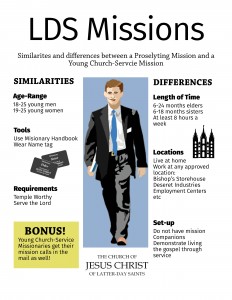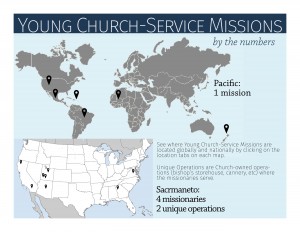Elder Nicholas Johnson knelt on the ground, clasped his hands and pleaded to understand why he couldn’t go to Mexico, why he had to be stuck in Utah serving his mission instead. Why had he even received a call if the acute anxiety attacks were going to prevent him from going?
It has become more apparent with the increase in number and diversity of missionaries that the traditional proselyting mission does not work for everyone. The Church of Jesus Christ of Latter-day Saints already has alternative mission options set up; Young Church-Service Missions are honorable alternatives for young people whose physical or mental situations are not ideally suited for two-years-on-their-own assignments. Opportunities for service can range from working in a local Bishop’s Storehouse to serving in a Family History Center. These opportunities provide earnest young men and women the chance to serve a mission when they otherwise would not be able to.
The number of young church-service missionaries is growing, but many are still not aware of the program or the possibilities it offers. The program has only been formally established since 2014, but an even larger factor in the unawareness is the widespread reach of proselyting missions. Since the LDS Church was established, proselyting missions have played a significant role in sharing the gospel. Many people are accustomed to seeing nicely groomed, cleanly dressed pairs of LDS missionaries riding bikes or walking the streets. Male members of the church grow up knowing they are expected to serve a mission — and the majority believe it’s a proselyting mission.
“In our church culture, we talk about regular, full-time missionary service,” said Greg Franson, General Manager of the Young-Church Service Mission Program. “And everybody knows what that means. That’s a proselyting mission.”
A proselyting mission requires worthy young men and women to serve 18 months to two years far from home. Many have to travel by foot or bicycle throughout their mission boundaries. They buy their own food, take care of their own living quarters, interact with members and nonmembers alike and teach the gospel.
Young church-service missionaries do not teach the gospel; instead, they serve others in a variety of different ways. And in the eyes of church leaders, that is just as important as proselyting.

Young Church-Service Mission program leaders are trying to get the word out to church members that a proselyting mission and a service mission are equally valued, both by the church and in the sight of God. Yet even with all the emphasis, the process of getting members to understand is likely going to be a slow one.
“It will take some time to shift the culture in the church to validate and appreciate a service mission in the same way a proselyting mission is viewed,” said Robert Buchanan, recently-called mission leader of the Boise, Idaho Young Church-Service Mission. “Right now, most members will think this is just something kids who can’t do a proselyting mission do because they can’t go on a ‘regular’ mission.”
Worthy young men who have been excused from serving proselyting missions and worthy young women are welcome to serve a church-service mission. Currently, the program provides opportunities for young men and women with physical or mental challenges to serve, and many of them have jumped at the chance to become a young church-service missionary.
“We have everything from a young quadriplegic with Down Syndrome working in a wheelchair serving as a greeter, to elders and sisters who have been honorably excused because they have bipolar disorder, they’re overweight, they have social disorders and in between are all these other challenges,” said Elder Steven Ostler, a coordinator for the Young Church-Service Missionary Program.
Despite the physical, mental or emotional challenges many young church-service missionaries face, their desire remains untarnished.
Robert and Stephanie Buchanan, mission leaders in Boise, Idaho, have witnessed the dedication of these young men and women firsthand. They recently met with a local branch president who wanted to introduce them to a young man who was interested in a service mission.
“…we heard some labored walking in the hall, and the young man appeared,” Stephanie Buchanan said. “(As we explained the program to him) the smile on his face grew bigger…until his entire face was radiating joy. Because of his physical challenges, (he) knew he could never serve a proselyting mission for the church, but the desire to serve had burned in his heart for four long years.”
Elder Johnson wasn’t quite as thrilled to be serving a young church-service mission at first. If an elder or sister is released early and honorably from a proselyting mission due to health concerns, they can choose to finish their assignment as a service missionary. This happened to Johnson. A recent convert, he submitted his mission papers and received a call to serve a proselyting mission in Aguascalientes, Mexico.He had no medical history or experience with anxiety before he started his mission, but when he was in the Missionary Training Center learning the lessons and preparing to leave for Mexico, he began experiencing acute anxiety attacks. He was sent home.
“It was a hard time,” Elder Johnson said. “I grew from coming home because I learned not to judge people, but it was still hard. Then I looked online and found out about the young church-service program. We called the Ostlers at the Church Office Building and arranged to meet them.”
His new assignment was to serve at the Centerville Employment Center. The transition from proselyting to service mission was not easy at first.

“There was a time during the early part of my (service) mission when I would get on my knees and say, ‘Heavenly Father, why me?’” said. “I had no signs of anxiety or depression before my mission, but when I started the mission…Why me? It was as if God drew his hand down from heaven and sort of grabbed me by the shoulder and shook me around. It was like he was saying, ‘I don’t care what other people think; I think this is what is best for you.’”
Returning home early from a proselyting mission due to health or other concerns is generally hard on an LDS missionary. Feelings of failure and disappointment often accompany such an experience. However, the opportunity to finish a service mission enabled Johnson to overcome those feelings and grow closer to God.
“More than anything, this service mission has given me the opportunity to grow. A lot of kids go out on missions and they grow for two years; spiritually, physically, mentally. (They grow) big time, because when the pressure is on, it makes you grow…I needed that chance to grow, but I needed it differently,” Johnson said.
Johnson has experienced both types of missions, and he understands the value of church-service missions in a personal way. Through his experiences, he has come to know that no matter the mission experience, the ultimate goal of the LDS Church is to bring people closer to God.
“I want to stress that…service and proselyting missions are the same,” he said. “Some members aren’t baptized until they are 50 years old and they didn’t get to serve a proselyting mission. God doesn’t care…You hear stories about people who go on proselyting missions who aren’t able to get anyone to baptize, and that’s hard on them, but they realize they were able to grow closer to God because of that experience. That’s what God ultimately wants and that’s the same with service missions.”
The program might be young, but the concept of service is old for Latter-day Saints. Members of the church are encouraged by leaders to serve their fellowmen in day-to-day life. Proselyting missionaries are asked to do the same as they preach the gospel. Young church-service missionaries embody service in their very actions and responsibilities. Both types of missions are deemed acceptable. Both are deemed honorable.




